Fascinating Insights into the Great White Shark
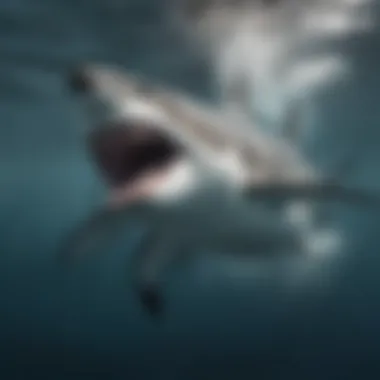
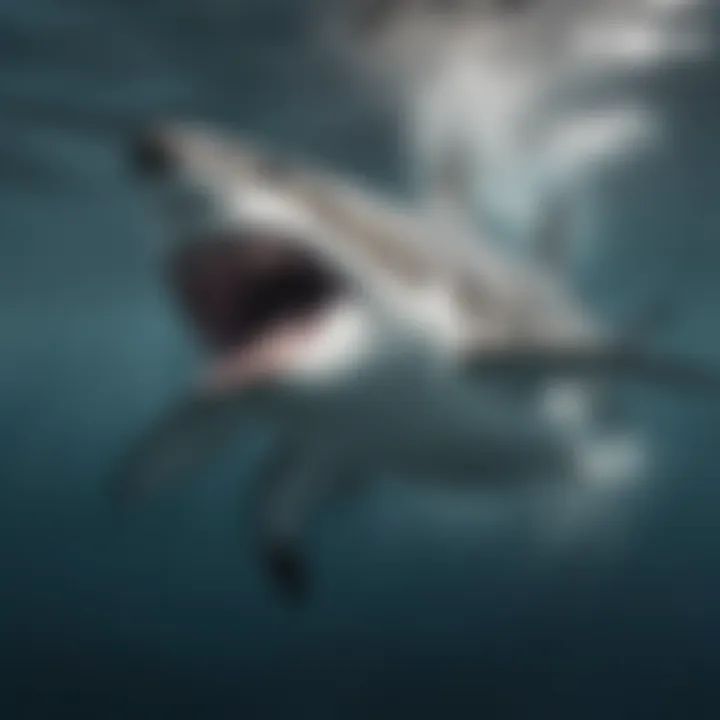
Intro
The great white shark, known scientifically as Carcharodon carcharias, reigns at the top of the oceanic food chain. With its impressive size, serrated teeth, and remarkable speed, it’s a creature that has captured the imagination of humanity for centuries. This predatory fish is not just a terror of the sea, but an intricate part of the marine ecosystem, playing a crucial role in maintaining the balance of ocean life.
In this article, we turn the spotlight on the great white shark—exploring its biology, behaviors, habitats, and the ecological functions it serves. We’ll delve deep into the conservation efforts aimed at protecting these formidable beings, while also reflecting on how humans perceive and interact with them. From scientific insights to cultural narratives, prepare to enter a world that is as demanding as it is awe-inspiring.
By understanding these dynamics, we can foster a greater appreciation for one of nature's most iconic marine life forms and advocate for their preservation in our oceans.
Understanding the Great White Shark
Understanding the great white shark is like holding a mirror to the ocean's most powerful predator. It's not just about knowing what it eats or where it lives, but diving deeper into the very essence of its biology and behaviors. As humble as it sounds, this knowledge matters. Not only does it enlighten our comprehension of marine ecosystems, but it also influences conservation efforts crucial to maintaining the balance of life in our oceans.
Biological Classification
Taxonomy
Taxonomy is the branch of science that deals with the classification of living organisms. In the context of the great white shark, its taxonomy sheds light on where it fits into the vast web of life in the ocean. The great white falls under the class Chondrichthyes, which encompasses all sharks and rays, and this is pretty fascinating. Knowing its taxonomic classification allows researchers to study its evolutionary history, drawing connections that span millions of years.
The key characteristic of its taxonomy is that it emphasizes its relationship to other species, not just in its immediate environment but globally. For our article, this classification serves as a fundamental stepping stone to broader discussions about marine biology. The unique feature of taxonomy in this case is its ability to highlight similarities and differences with other species, which can lead to important conservation insights or misunderstandings about its behavior.
Species Overview
When exploring species overview, we focus on the great white shark's distinguishing traits and behaviors. The great white specifically belongs to the species Carcharodon carcharias, known for its impressive size and hunting prowess. Highlighting this gives a clear picture of what sets this species apart from others, making it a compelling subject for those looking to understand the shark more intimately.
A unique feature here is its survival strategy—great whites are built for the hunt. They're apex predators, meaning they sit at the top of the food chain, seemingly unaffected by other predators. This aspect is beneficial for the article, as it opens doors to discuss its ecological role further, tapping into why it's crucial to preserve such a magnificent species.
Related Species
In examining related species, we open the door to understanding evolutionary relationships among sharks. For instance, the great white is closely related to the mako and the tiger shark. These connections provide context on evolutionary adaptations that enhance survival in their respective environments, linking behaviors, and characteristics between species.
Their key characteristic is how these related species share traits, such as a keen sense of smell or powerful bursts of speed. This comparison effectively enriches our article by introducing a family tree of sorts, presenting the reader with the big picture of the shark family tree. Yet, while these similarities exist, each species has adapted in unique ways that highlight the variety of life forms in our oceans.
Physical Characteristics
Size and Weight
When you think about size and weight, great whites stand tall—well, not literally, but you get the idea. They can grow upwards of twenty feet long and weigh more than two tons. This immense size is crucial for both their predatory efficiency and social standing in the ocean ecosystem. Citing their size provides a fun yet serious element to our narrative; it paints a visual that captures attention.
What sets this information apart is the role size plays in hunting strategies. It allows the great white to target larger prey, which is key to their survival. However, size comes with its burdens as well, like finding enough food to sustain that physique, making this aspect a double-edged sword in their ecological narrative.
Coloration Patterns
The coloration patterns of the great white shark are another striking feature; their dark, mottled backs contrasted with white underbellies serve a purpose—camouflage. This is called counter-shading and is vital for avoiding detection by prey swimming above and below them. Recognizing this characteristic helps bridge our understanding of how they interact within their environment.
The unique feature of their coloration lies in its effectiveness in hunting. A shark's ability to remain hidden just below the surface can give it a distinct advantage. It highlights a crucial survival tactic and further underscores the necessity to protect these animals from practices that threaten their natural habitats, including pollution and overfishing.
Anatomical Adaptations
Delving into anatomical adaptations provides incredible insights into how the great white is engineered for survival. From their acute sensory perception to their streamlined bodies designed for swimming, each characteristic serves a purpose in their predatory lifestyle.
For instance, their unique feature of powerful jaws not only allows them to capture larger prey but also gives them the ability to tear flesh with ease. This anatomical prowess is key for understanding the great white's role in the food web, adding layers to our narrative and emphasizing the importance of these adaptations in a changing ocean.
In summary, comprehending the great white shark reveals its biological significance and intricate relationships in marine ecosystems. This knowledge doesn't just scratch the surface; it offers us a deeper appreciation of the delicate balance within ocean habitats and the ongoing need to protect such vital species.
Domicile of the Great White
Understanding the domicile of the great white shark is essential for grasping its ecological role and survival strategies. This section dives into where these formidable predators make their homes and how their habitats shape their behaviors and interactions with the marine world.
Habitat Range
Global Distribution
The global distribution of great white sharks is widespread, covering the temperate and subtropical waters across the globe, ranging from California's coast to the shores of South Africa and Australia. This distribution is vital because it highlights their adaptability to various environments.
- One striking aspect of global distribution is how, despite being mainly coastal species, they can also venture into open ocean areas. This flexibility allows them to follow migrations of their prey, such as seals and smaller fish, ensuring their survival.
- A unique characteristic is their tendency to inhabit specific areas called "hotspots", where ocean conditions—like water temperature and food availability—are just right. The advantage? These regions provide plenty of sustenance, but the disadvantage might be increased competition with other apex predators.
Preferred Environments
Great white sharks show a strong preference for particular environments that offer suitable conditions for hunting and breeding. They thrive in waters that are rich in marine life, like those near seal colonies.
- The benefit of these environments is clear: more food equals better energy for hunting and reproduction. They frequently inhabit areas with kelp forests, underwater canyons, and continental shelves, all of which are rich in biodiversity.
- However, these locations can also have downsides; factors such as human activity and pollution can drastically impact their preferred habitats, affecting not just their population but the entire marine ecosystem.
Migration Patterns
Migration patterns of great white sharks are another critical aspect of their domicile. These sharks move extensively between feeding and breeding grounds.


- One compelling feature of their migration is the seasonal patterns observed; in warmer months, they tend to migrate northward to feed on abundant prey. During colder months, they move south to breed and find more hospitable conditions.
- This seasonal migration is not just a survival tactic but also serves to maintain the balance within marine ecosystems. However, increased human interference, such as boating and fishing, disrupts these migration routes, posing a significant threat to their life cycle.
Environmental Adaptations
Thermoregulation
Thermoregulation is a crucial adaptation that allows great whites to maintain their body heat in colder waters. Unique physiological adaptations help them survive in diverse climates.
- Great white sharks are endothermic, which means they can regulate their body temperature. This allows them to hunt efficiently even in chilly waters, giving them an edge over prey that are less tolerant to cold.
- However, the downside to this adaptation is that it requires a significant energy expenditure, necessitating adequate food sources to sustain their metabolic demands during long hunts.
Depth Preferences
Sharks display a fascinating range of depth preferences, which influences their hunting strategy. They often swim at various depths depending on the time of day and the availability of food.
- Typically, they are found at depths of around 600 feet but can dive deeper when necessary. This flexibility aids in seeking out prey or evading competitors.
- The unique feature here is that certain depths also provide a thermal refuge during hot summer months. Yet, this behavior means that they are at risk from overfishing at those depths, disrupting their natural hunting patterns.
Impact of Ocean Currents
Ocean currents play a pivotal role in the lives of great white sharks, influencing their migration and feeding behaviors. These currents can significantly affect the distribution of marine life and, consequently, their prey.
- Strong currents can enhance nutrient upwelling areas that attract smaller fish and, in turn, prey for the great white. This makes certain regions, especially where currents converge, hotspots for feeding. However, unpredictable changes in ocean currents due to climate change could disrupt these connections, posing potential threats to their ongoing survival.
The study of great white sharks continues to reveal intricate links between their habitat choices and the larger marine ecosystem they inhabit.
Behavioral Insights
The behavioral patterns of the great white shark are not just intriguing; they provide crucial context to the species' role in marine ecosystems. Understanding how these majestic predators interact with their environment shows their importance in maintaining the balance within oceanic life, often serving as indicators of the health of marine ecosystems. Clearly, any discussions about great white sharks must delve into their behavioral traits, such as feeding habits, social interactions, and various survival strategies. This section covers significant behavioral aspects that cater to a range of readers, from marine biologists to outdoor enthusiasts.
Feeding Habits
Feeding is a central part of a great white shark's life, and their habits are fine-tuned by millions of years of evolution.
Prey Selection
Great white sharks are often termed apex predators due to their ability to selectively hunt specific types of prey. They tend to favor marine mammals—particularly seals and sea lions—due to the high caloric content these animals provide. A key characteristic of their prey selection is the emphasis on size and vulnerability: great whites often go for younger or smaller individuals, which enhances their hunting success. This beneficial choice ensures that they can maintain their energy levels efficiently while hunting.
One unique feature of prey selection is the use of breaching behavior. When a shark launches itself out of the water, it can catch its unsuspecting prey by surprise, a strategy that’s both dramatic and effective. This method might have disadvantages, as it requires a lot of energy and puts the shark in a vulnerable position for a split second. However, the high rewards often outweigh the risks.
Hunting Techniques
The hunting techniques of great white sharks are similarly fascinating. They primarily employ sneak attacks, gliding silently through the water before launching a rapid strike. A noteworthy detail in this hunting style is how they rely heavily on their acute sense of hearing and electro-reception to locate prey. This approach is a popular choice because it plays to their strengths—speed and stealth.
One unique aspect of their hunting technique is the "spy hopping" behavior, where a shark raises its body vertically to inspect its surroundings. This behavior gives them a clear view of potential prey and is also used to gauge environmental conditions without exposing themselves fully. The downside, though, is that it can give away their position to other potential prey and competitors.
Scavenging Behavior
While great whites are often hailed for their hunting prowess, their scavenging behavior is equally compelling. They are opportunistic feeders, willing to consume carrion if it presents itself. A key feature here is their ability to detect the scent of decaying flesh from miles away, which adds to their effectiveness as scavengers. This trait is a beneficial choice for their survival, particularly when prey is scarce.
One unique feature of this scavenging aspect is the social dynamics that can come into play, particularly when multiple sharks converge on a carcass. In these scenarios, they can exhibit complex behaviors, such as maintaining distance from one another or establishing dominance hierarchies. The downside, however, is increased competition which can lead to aggressive interactions, sometimes risking injury.
Social Interaction
Social interactions among great white sharks paint a complex picture of their behavioral ecology. These sharks may not seem social in the conventional sense, but they do engage in a variety of behaviors that suggest some form of interaction and communication.
Territorial Behavior
Great white sharks are generally considered solitary, but this doesn't mean they lack territorial behaviors. They often exhibit dominance over certain areas known to harbor plentiful prey. A key characteristic of territorial behavior is the sense of space—they can display aggressive actions towards other sharks that invade their territory. This emphasis on territory is a valuable behavior as it helps ensure their access to food resources.
One unique feature of this territorial aspect is the concept of space hierarchy. Larger, more mature sharks tend to establish dominance in richer feeding grounds, forcing smaller ones to the margins. The disadvantage is the inherent risk of conflict, which could potentially lead to injuries or suboptimal feeding opportunities.
Reproductive Practices
Reproductive practices in great white sharks reveal a lot about their life cycle. Engaging in a form of internal fertilization, female great whites often give birth to live young after a gestation period of nearly a year. A key characteristic of their reproductive practices is the size of the pups at birth; they can measure up to 4.5 feet long, giving them a fighting chance in the wild. This strategy is a beneficial choice to ensure a higher survival rate for newborns.
One unique feature of their reproductive behavior is the phenomenon of "embryonic cannibalism," where the largest embryos consume their smaller siblings in the womb. While sounding harsh, this behavior ensures that only the strongest survive to birth, optimizing the chances of survival in a predatory environment.
Parental Investment
When we think of parental care, sharks might not be the first creatures that come to mind, yet the great whites do exhibit behaviors that can be interpreted as parental investment. Though not nurturing in the typical sense, female great whites tend to choose safer habitats for birthing their pups. A key characteristic of parental investment in this species is the choice of the birthing ground. They select locations that provide cover and abundant food.
One unique facet of this parental behavior is the ‘fleeing’ instinct of pups, which drives them away from their mothers soon after birth. This behavior is designed to minimize competition for resources and avoid potential predation by other larger sharks. On the downside, it poses risks as the young are left vulnerable without adult protection for an extended period.
Through exploring these diverse behaviors, we gain a deeper appreciation for the multitude of adaptations that the great white shark has developed over time. These insights not only enrich our understanding of this species but also emphasize its critical role within the marine ecosystem.
Role in Marine Ecosystems
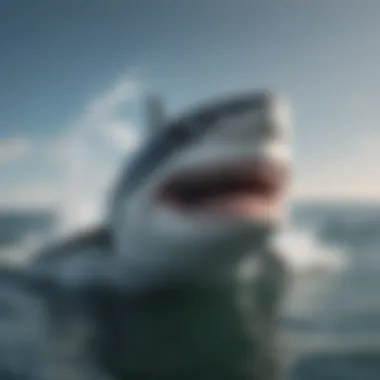
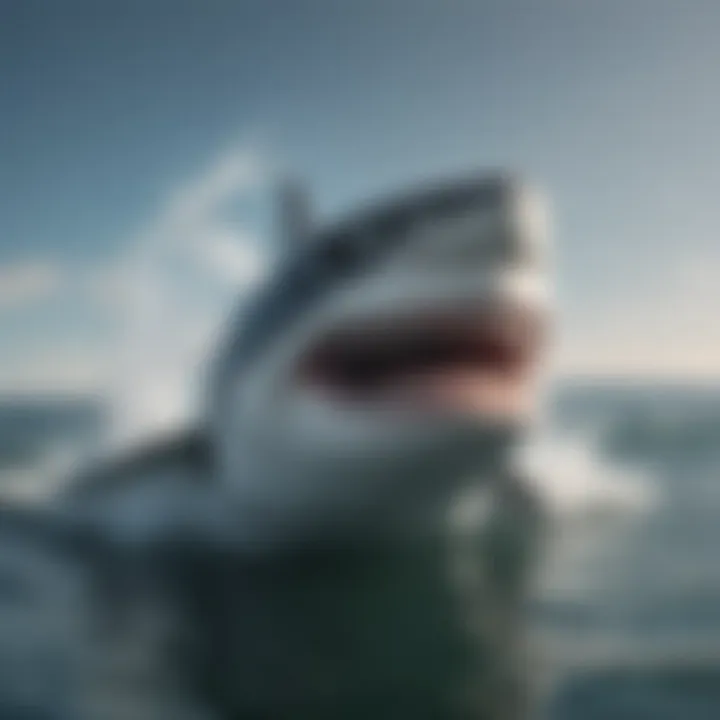
The great white shark plays a pivotal part in maintaining the health and balance of marine ecosystems. Its role extends far beyond that of a mere predator; it is a crucial player in the intricate web of oceanic life. Throughout the world’s oceans, these formidable creatures help regulate fish populations and maintain the ecological equilibrium that sustains various marine species. In this section, we'll delve into their predatory influence and symbiotic relationships, highlighting how the great white shark contributes to the delicate harmony of marine ecosystems.
Predatory Influence
Maintaining Species Balance
Great white sharks are often regarded as apex predators, meaning they sit at the top of the oceanic food chain. This position allows them to maintain species balance across their habitat. When these sharks hunt, they primarily target sick, weak, or older fish. This selective predation helps keep prey populations healthy, preventing overpopulation and ensuring genetic integrity remains intact. A balanced ecosystem leads to more resilient marine habitats where diverse organisms thrive. Furthermore, as numbers of great white sharks diminish due to human activity, the imbalance in the ecosystem becomes evident. A key characteristic of maintaining species balance is the predator’s ability to regulate prey dynamics, which serves as a beneficial aspect of their existence. However, human interference complicates this role, making conservation efforts increasingly critical.
Impact on Prey Populations
The characteristics of great white sharks in relation to their prey are crucial for understanding their role in marine ecosystems. Their hunting strategies create a direct impact on local fish populations. As dominant hunters, great white sharks influence the number and behavior of species such as seals, fish, and even sea turtles. For example, when a population of seals is kept in check, the pressure on smaller fish species decreases, allowing them to repopulate. The unique feature of this influence is the cascading effect it has on marine life, demonstrating that the presence of great whites can lead to healthier fish stocks and increased biodiversity. However, in regions where these sharks have been overfished, researchers have observed disturbing changes in prey behavior and population dynamics, emphasizing the need for robust management strategies.
Ecological Importance
Beyond their predatory influence, great white sharks contribute significantly to the overall ecological importance of marine environments. Their existence impacts not only prey species but also the functioning of the entire marine ecosystem. The presence of these sharks helps promote biodiversity by allowing smaller predator species to thrive as competition lessens. In turn, this biodiversity supports the resilience of ecosystems amid environmental changes. The beneficial nature of this impact cannot be overstated, as it ensures a balanced environment capable of recovering from disturbances. However, should shark populations continue to decline, the resulting ecological consequences could disrupt various marine food webs.
Symbiotic Relationships
Interactions with Other Marine Life
The great white shark's interactions with other marine species reveal a fascinating aspect of their existence. They often share their habitat with smaller shark species, creatures such as remoras, and large marine mammals. These relationships might seem purely opportunistic, but they often come with mutual benefits. For instance, remoras gain protection by hitching rides on sharks, while the sharks receive cleaning services from the remoras by getting rid of parasites. This characteristic of interactions exhibits the intricate relationships within ocean ecosystems. By recognizing the interdependence of species, we see how these dynamics play a role in the health of the marine environment. However, the disruptions caused by overfishing could hinder these relationships, resulting in unpredictable outcomes.
Coexistence with Other Predators
Great white sharks share their territory with various other predators, such as tiger sharks and orcas. Their coexistence highlights an ecological balance where each predator maintains its niche while influencing prey populations differently. This balance allows for greater stability within the marine ecosystem. Interestingly, these competitive dynamics can lead to unique behavioral adaptations; for instance, great whites often adjust their foraging strategies based on the presence of competing species. The advantage of such coexistence is the resilience it nurtures within the ecosystem; diverse predator populations can absorb disturbances, promoting a more stable marine environment. Yet, the growing threat of human activities raises alarms that could unravel these established food webs, prompting immediate attention.
Impact on Coral Reefs
While great white sharks largely inhabit open waters, their role still touches the vital ecosystems found in coral reefs. These reefs rely heavily on maintaining balanced fish populations to thrive. Sharks contribute indirectly by controlling herbivore fish like parrotfish, which play a part in preventing harmful algae overgrowth. By maintaining healthy fish populations, great whites promote thriving coral reefs, underscoring their ecological importance. This feature highlights the interconnectivity of oceanic inhabitants. The disadvantage, however, is that if shark populations dwindle, coral reef health may decline due to altered fish dynamics, compromising their ecological integrity.
"Sharks aren't just about fear; they are life guarantors for the underwater world. Without them, we'd face an ecological disaster."
Understanding the incredible role of great white sharks in marine ecosystems provides valuable insight into their necessity for health and stability in our oceans. Their predatory influence not only maintains species balance but also fosters complex relationships with other marine species. However, it is evident that threats to their survival continue to loom, amplifying the importance of conserving these apex predators.
Conservation Challenges
Addressing the conservation challenges faced by great white sharks is crucial in understanding the ongoing survival of this iconic species. These challenges not only impact the sharks directly but also influence the broader marine ecosystem. To fully grasp the stakes, it’s important to dive into various threats and conservation efforts focusing on these apex predators.
Threats to Survival
Overfishing
Overfishing brings substantial worry to the oceanic landscape and great whites are no exception. Shark populations, including that of the great white, are often targeted due to the high demand for their fins, meat, and even cartilage. This contributes significantly to the decline in their numbers.
One of the key characteristics of overfishing is its unsustainable nature. Fishers often capture more than can be replenished, leading to permanently diminished populations. As a beneficial point, addressing overfishing can restore ecological balance, allowing the shark populations to rebound. Additionally, more and more communities are recognizing overfishing's detrimental impact, leading to stronger calls for regulations and sustainable practices within fisheries.
Habitat Destruction
The ocean is their home, but habitat destruction disrupts the balance where great whites thrive. Coastal developments, pollution, and climate changes lead to the degradation of vital habitats. The critical aspect here is that these sharks rely on specific environments for breeding and hunting. The loss of such areas proves detrimental, as it not only limits their territory but also stresses the already fragile population.
Habitat destruction remains a poignant topic because its effects are often subtle but far-reaching. As habitats shrink or undergo transformation, sharks may struggle to find suitable conditions for their life processes. This destruction raises alarms in marine biology circles regarding their long-term viability in the ever-changing ecosystem.
Climate Change Effects
Climate change poses a multifaceted threat impacting great white sharks in various ways. Notably, sea temperature changes can affect their prey distribution, directly influencing hunting patterns. More warmth in the ocean also opens up new territories for them, yet it can lead to unpredictable shifts that complicate their migration patterns.
The leading characteristic here is the unpredictability that climate change introduces into the natural environment. Its global effects are felt in every corner of the earth, making it a strong topic of concern. While it's essential to address climate change through awareness and proactive measures, the shark populations remain particularly vulnerable, illustrating the need for focused conservation strategies.
Conservation Efforts
Protected Areas
Establishing protected marine areas is one of the most effective strategies in conservation efforts concerning great white sharks. These designated spaces provide a refuge away from fishing and other harmful activities. The unique feature of protected areas lies in their ability to allow ecosystems to rejuvenate and thrive.
Such areas offer enormous advantages, including boosting the numbers of marine life and creating a safe haven for reproductive activities. As researchers continue to find new protected areas suitable for sharks, local fisheries often benefit from the recovery of marine species in the long run.
Legislation
Legislation plays a pivotal role in not just the ideological aspects of shark conservation but also the practical enforcement of protective measures. Policies to ban shark finning and regulate fishing quotas have seen some success. A key characteristic of effective legislation is its ability to create tangible, enforceable protections for marine life.
The unique feature here is that legislation can be both reactive and proactive. It adapts to new developments in marine biology and public opinion, making it a vital tool in shark preservation. Prospective laws and regulations can hinder overfishing and habitat destruction, setting a critical path towards sustainability.
Public Awareness Campaigns
Lastly, public awareness campaigns have gained momentum in recent years, driving discourse surrounding great white sharks. These efforts educate the public about the ecological importance of sharks and the dire threats they face. The great characteristic of such initiatives is their potential to change perceptions, which can ultimately lead to greater support for conservation.
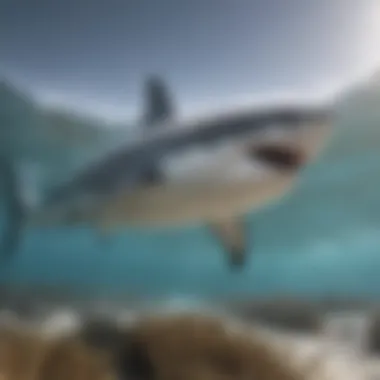
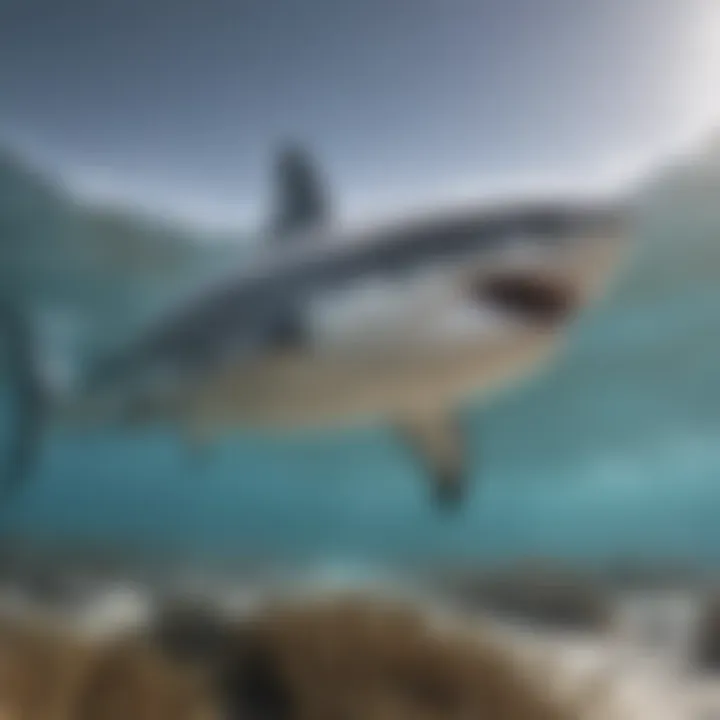
Public campaigns have unique advantages, including fostering community involvement in shark conservation and eco-friendly tourism practices. Through effective storytelling and factual outreach, these efforts facilitate a shift in public perception, promoting a deeper appreciation for the importance of sharks in marine systems.
By understanding the multifaceted conservation challenges surrounding great white sharks, we set the stage for meaningful discussions and actions that could shift the tide towards a sustainable future for these remarkable creatures.
Human Interactions
Human interactions with great white sharks encompass a complex interplay of culture, safety concerns, and ecological awareness. Understanding these interactions is crucial because they shape both perceptions and policies toward these powerful creatures. Humans often view sharks through a tangled lens of fascination and fear. This duality is essential in forming a more holistic understanding of the species, its conservation challenges, and fostering safer encounters.
Cultural Significance
Myths and Misconceptions
Myths about great white sharks run rampant, creating a fog of misunderstanding around their behavior. The popular image of sharks as mindless killers often overshadows their ecological importance. One popular myth is that all sharks actively seek out humans as prey. This misconception does a disservice to the reality that sharks often bite humans out of curiosity rather than malice. By dissecting these myths, we foster a more informed public. The humanizing narrative that sharks have motives aligned with survival and not with predation helps highlight that their bites are typically exploratory. This characteristic of sharks holds immense significance in shaping conservation dialogues.
Representation in Media
The portrayal of sharks in media often contributes to public perceptions, and this aspect should not be overlooked. Films like "Jaws" dramatize the shark's predatory image, cementing a fearful stance in public consciousness. While thrilling, these representations can hinder efforts for shark conservation. Documentaries, on the other hand, often aim to showcase their behaviors, emphasizing their role as vulnerable species that need protection. The challenge lies in balancing entertainment with education. Inaccurate representations may influence uninformed decisions by beachgoers, impacting tourism and shark conservation efforts.
Impact on Tourism
The allure of great white sharks plays a significant role in ecotourism, drawing thrill-seekers to destinations that offer shark cage diving or observation. This aspect is a double-edged sword. On one hand, it generates income for local economies and raises awareness for conservation initiatives. On the other, it poses risks if done irresponsibly. There’s a fine line between thrill and safety, necessitating stringent regulations about human-shark interactions. The economic benefits, such as increased tourism revenue and educational opportunities, underline why we must approach this interaction with caution and respect, ensuring that conservation takes center stage.
Safety and Encounters
Shark Attacks
Shark attacks, although infrequent, attract substantial media coverage, perpetuating the fear surrounding these creatures. Statistically, the odds of getting bitten are astronomically low; however, sensational stories can lead to an exaggerated sense of danger. This dynamic becomes critical in informing beach safety measures and public education. It's vital to present the reality of shark attacks within the broader context of human risk and behavior in ocean environments. Most attacks occur because sharks mistake humans for their usual prey. Understanding this can help put the issue in perspective.
Preventative Measures
Implementing preventative measures to enhance safety is essential in areas where human-shark encounters are more common. Initiatives like shark nets, beach monitoring systems, and educational signage can mitigate risks significantly. These measures not only protect beachgoers but also aim to reduce shark fatalities from unnecessary culling often caused by fear. Promoting swimming in groups, avoiding twilight hours, and steering clear of fishing or baited areas further boosts safety.
Responsible Diving Practices
The facets of responsible diving practices cannot be overstated when it comes to interactions with sharks. Divers can engage positively with these creatures by following guidelines that prioritize both human and shark safety. Practices like maintaining a safe distance, avoiding erratic movements, and diving within established guidelines are pivotal. Such interactions can foster appreciation for sharks and contribute to conservation efforts. Encouraging divers and surfers to respect the space of these magnificent animals ensures that their future is safeguarded while allowing humans to enjoy the thrill of encountering them in the wild.
By understanding and mitigating the fears surrounding great white sharks, we can foster a balanced perspective that encourages both safety and conservation.
Future Perspectives
The future of great white sharks is a mixed bag of possibilities and challenges. As we delve into the intricacies of their existence, understanding the upcoming trends and needed actions will be vital. Focusing on aspects like research advances, public engagement, and community involvement can make a significant impact. These elements not only hold potential benefits for sharks but also for people who require this knowledge for better coexistence with these majestic creatures.
Research Advances
Tracking Technologies
One of the most exciting aspects of tracking technologies relates to satellite tracking devices. These tools have drastically changed our understanding of migration patterns and behavior of great white sharks. A notable characteristic of these devices is the ability to gather real-time data, allowing researchers to follow these majestic animals as they wander through vast oceanic spaces. This insight turns out beneficial for both conservation efforts and public safety, especially in coastal areas prone to shark sightings.
The unique feature of these satellites is their accuracy. They can pinpoint the location of an individual shark down to a few meters. However, these technologies come with drawbacks as well. Installation requires capturing the shark, which causes stress. Not every shark will survive the handling process. Thus, while tracking technologies shine a light on some mysteries, they can also raise ethical questions.
Genetic Studies
Genetic studies have revealed surprising insights into great white sharks. One major aspect is the examination of genetic diversity among populations. This is crucial for understanding their adaptability to changing environments. The key characteristic here is the ability to trace lineages and interbreeding, which informs conservation strategies. With emerging threats like climate change, knowing which populations are more resilient could guide future interventions.
The unique feature found in genetic studies is advanced genome sequencing. This method allows for a fine-tuned analysis of genetic variations. However, genetic studies can be costly and require cutting-edge technologies, potentially putting them out of reach for some research programs.
Population Dynamics
Understanding population dynamics plays a significant role in maintaining healthy ecosystems. It encompasses the study of how various factors like mortality and reproduction influence shark numbers. The key characteristic of this area is the marriage of ecological modeling and actual field data. Data collected over time can paint a picture of population trends, important for assessing the health of the species.
The unique feature here is that this approach doesn’t just focus on sharks but considers their prey and environment as well. This holistic view can be incredibly advantageous, yet gathering accurate data can be daunting. Long-term studies often necessitate a commitment of resources that some institutions might not possess.
Public Engagement
Community Involvement
Community involvement is a cornerstone when discussing future perspectives on great white sharks. Engagement at the ground level can foster local support for conservation initiatives. The key characteristic here is the collaborative nature of these efforts, drawing together scientists, local fishermen, and beachgoers. When people are informed, they can take part in meaningful dialogues, thus paving the path to sustainability.
A unique feature of community involvement is its ability to foster local stewardship. When communities appreciate the sharks, they are more likely to protect their habitats. Yet, the challenge remains of ensuring consistent participation from diverse stakeholders. Getting everyone on the same page can be like herding cats sometimes.
Ecotourism Potential
Ecotourism offers another avenue to engage the public while supporting conservation. The promotional aspect of ecotourism highlights the beauty of sharks and how vital they are in marine ecosystems. This creates economic opportunities for local communities through shark tourism, which can serve as a buffer against overfishing. The key characteristic is the sustainable approach that benefits both the local economy and marine life.
A unique feature is the blend of adventure and education that ecotourism provides. It opens pathways for visitors to learn about shark behavior and ecology firsthand. However, poorly managed tourism can lead to disturbances in the sharks’ natural behavior, making it a double-edged sword in some scenarios.
Educational Initiatives
Educational initiatives are another pivotal element. They aim to raise awareness about great white sharks among the general public. The key characteristic here is the multi-platform approach, utilizing social media, workshops, and educational programs. It is beneficial as it fosters knowledge-sharing and empowers individuals to take responsible actions.
One unique feature is the integration of technology in educational settings, with virtual reality experiences allowing users to dive into the ocean and meet sharks. Still, creating truly engaging content that resonates can be a challenge. Not everyone connects with scientific messages; thus, finding a balance in messaging is key.
In summary, focusing on these future perspectives will not only chart the course for great white sharks but also guide human interaction with the species. Education, engagement, and research will provide the needed foundation for a harmonious future.















